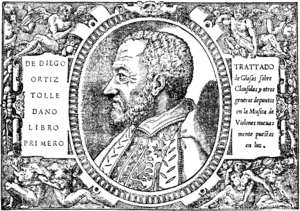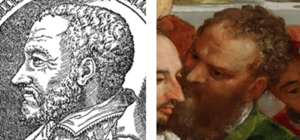Diego Ortiz facts for kids
Diego Ortiz (born around 1510, died around 1576) was a talented Spanish composer and music expert. He worked for the Spanish rulers in Naples, which was a part of Spain at the time. Ortiz is famous for writing the very first guide on how to add fancy musical decorations, called "ornamentation," to music played on string instruments like the viola da gamba. He also published a big collection of religious songs.
About His Life
We don't know much about Diego Ortiz's early life. People believe he was born in a city called Toledo in Spain. He likely passed away in Rome, Italy, where his records stop.
In 1553, Ortiz was living in Naples, which was then a Spanish territory. Five years later, a powerful leader named Fernando Álvarez de Toledo, the third duke of Alba, chose Ortiz to be the music director of the Chapel Royal of Naples. This was a very important job, leading the music for the royal family.
Ortiz still held this position in 1565, working for the Viceroy Pedro Afán de Ribera. Some recent studies suggest that Diego Ortiz might be the person shown in a famous painting by Paolo Caliari Veronese called "The Wedding at Cana". This idea comes from the musical instruments in the painting and how much the painted person looks like Ortiz's only known portrait.
New information shows that after working for the Spanish court in Naples, Ortiz also worked for the Colonna family in Rome. He was part of their household, or "famigliare", from at least April 1572 to September 1576.
His Music Books
Ortiz published two important music books during his life. These were Trattado de Glosas in 1553 and Musices liber primus in 1565.
Trattado de Glosas
The Trattado de Glosas (which means Treatise on Ornamentation) is considered a very important book for anyone who plays the viola da gamba. This book was published on December 10, 1553, in Rome. It had a Spanish title, Trattado de glossas sobre clausulas y otros generos de puntos en la musica de violones nuevamente puestos en luz.
At the same time, an Italian version was also published. This version had many Spanish words in it, which makes people think that Ortiz himself translated it into Italian.
Musices liber primus
In 1565, Ortiz published a collection of polyphonic religious music in Venice. Polyphonic music means music with several independent voice parts singing or playing at the same time.
This book, called Musices liber primus hymnos, Magnificas, Salves, motecta, psalmos, included 69 different songs. These songs were written for four to seven voices and were based on older plainchant melodies. The style of these songs was a bit old-fashioned for the time, but this suited the tastes of Pedro Afán de Rivera, the Duke of Alcalá and Viceroy in Naples, who was Ortiz's boss.
In the introduction to this book, Ortiz encouraged musicians to use instruments to play along with these sacred songs. This was a common practice in Spain back then. He also promised to publish another book of masses later, but that book never appeared.
See also
 In Spanish: Diego Ortiz para niños
In Spanish: Diego Ortiz para niños



